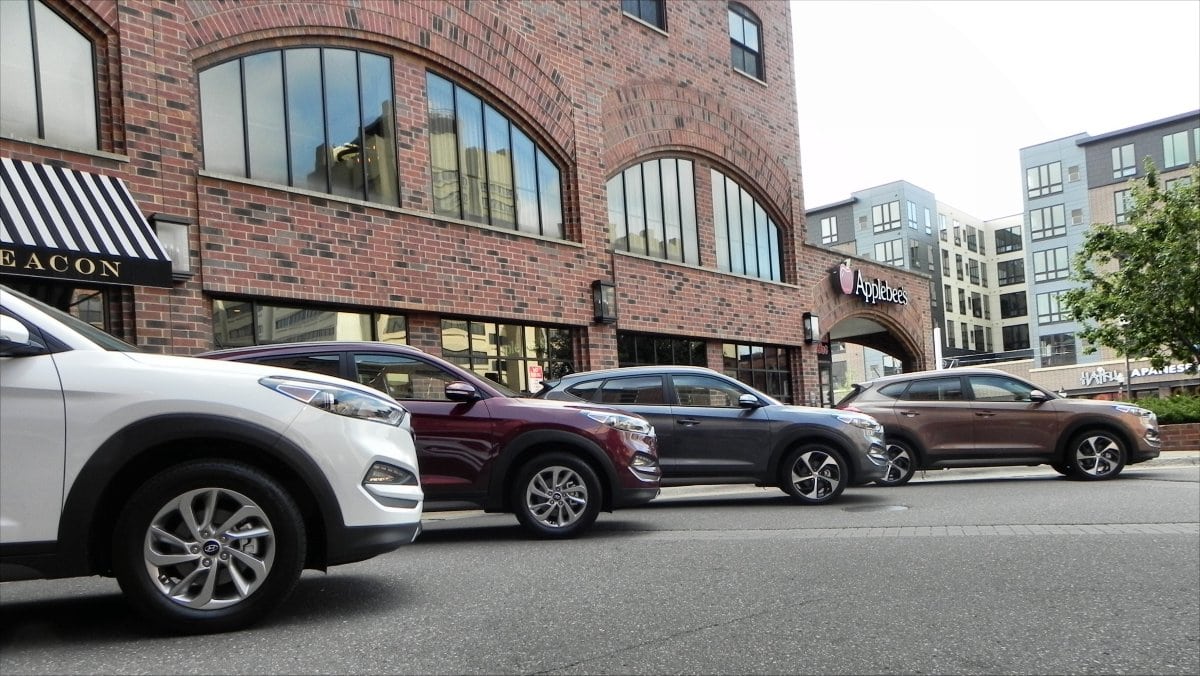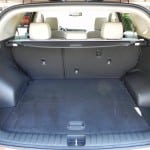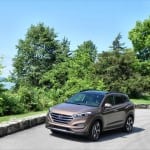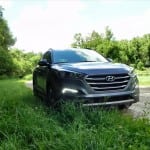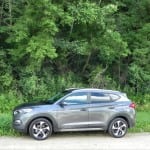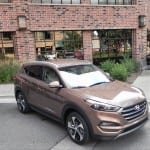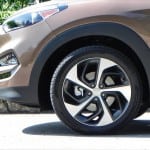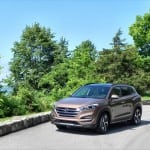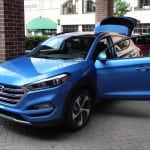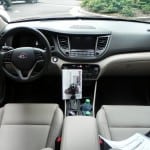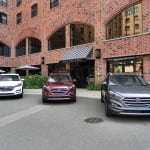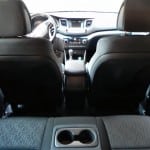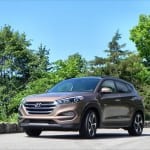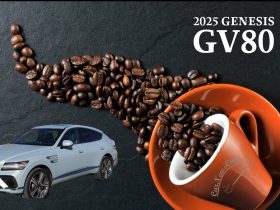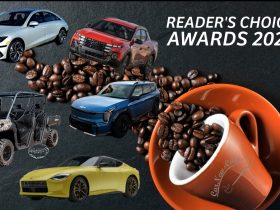CarNewsCafe was invited to Minneapolis, Minnesota to test drive the all-new 2016 Hyundai Tucson. We were stationed downtown right at the center of the UM campus and drove the Tucson through town and out into the hills for a beautiful summer day of winding roads in the hill country of Minnesota.
 We’ll get into some hard details on the Tucson later, but here are a few highlights that will help bring context to the impressions we had of the new crossover.
We’ll get into some hard details on the Tucson later, but here are a few highlights that will help bring context to the impressions we had of the new crossover.
- Great design elements with a lot of “Z” in the overall language.
- The 2016 Tucson is bigger (longer, wider), but not heavier than its predecessor.
- A 2.0-liter base engine offers average power output for average fuel economy.
- A new turbo engine offers much more power with better fuel economy.
- A dual-clutch transmission is introduced.
- The new all-wheel-drive system features unique vectoring that incorporates braking control in the mix.
- Finally, a lot of high-strength steel and chassis/body frame stiffening was done, to the tune of more than twice the stiffness than the Tucson had before.
All of these things add up to a very new drive experience that’s unusual for the small crossover segment. To nutshell our impressions, the new 2016 Hyundai Tucson drives like a fast-paced Volkswagen Tiguan but has the roominess and cargo capacity of the more mainstream crossovers like the RAV4 and CR-V. In short, the new Tucson is the best of all worlds and may have set a new benchmark for the industry. We’ll detail more of the changes made in another article, coming soon.
Driving the Upper-crust Limited AWD Tucson
 Our first drive was in the 2016 Tucson Limited with the all-wheel drive package. This model featured the 1.6-liter turbocharged engine and advanced dual-clutch transmission as well as the new torque vectoring AWD system. I was in the passenger’s seat for the first half of the drive, which took us out of the city and into the hills before we crossed the Mississippi River.
Our first drive was in the 2016 Tucson Limited with the all-wheel drive package. This model featured the 1.6-liter turbocharged engine and advanced dual-clutch transmission as well as the new torque vectoring AWD system. I was in the passenger’s seat for the first half of the drive, which took us out of the city and into the hills before we crossed the Mississippi River.
The Limited model is the top shelf for the 2016 Tucson and features a beautiful interior with a beige on beige leather scheme. I deliberately chose one in the new Mojave Sand color in order to see how this color looked out on the road and in various lighting conditions. It’s a great shade for those who like a rich brown tone. It’s eye-catching and Hyundai told us they expect it to make up about 4-5 percent of the color choices in sales volume.
The passenger’s seat is very comfortable in the Tucson with a great view of the road and easy access to infotainment and other controls. Head, knee, and legroom are all excellent in this new, larger crossover.
 When I took the wheel, I found the new engine to be very sporty and peppy. It accelerates well, never feels as if it’s struggling (even in the hill country) and the seven-speed dual-clutch transmission is a dream. For those who haven’t experienced a proper dual-clutch automatic, it’s a very different experience from a standard torque-based automatic or a manual transmission. The dual clutch allows the transmission to anticipate and pre-shift, giving it a faster response and smoother shift than you’ve probably felt before.
When I took the wheel, I found the new engine to be very sporty and peppy. It accelerates well, never feels as if it’s struggling (even in the hill country) and the seven-speed dual-clutch transmission is a dream. For those who haven’t experienced a proper dual-clutch automatic, it’s a very different experience from a standard torque-based automatic or a manual transmission. The dual clutch allows the transmission to anticipate and pre-shift, giving it a faster response and smoother shift than you’ve probably felt before.
The 2016 Hyundai Tucson Limited AWD rang in at $32,510, delivered, and had a host of amenities including infotainment and app options in the large touchscreen on the dash.
We stopped for lunch and swapped drivers again, this time switching to a more mid-priced, less flashy model and trim.
On the Road in the 2016 Tucson Sport FWD
This time, we chose a Coliseum Gray 2016 Hyundai Tucson Sport model with front-wheel drive. Adorned with a black cloth interior, the seating is still very comfortable and there is enough variation in the upholstery and stitching within the Tucson that a black-on-black interior doesn’t look plain. Priced at $27,170, delivered, this Tucson Sport had no added features except carpeted floor mats ($125). All else was standard for the Sport model.
Still powered by that 1.6L turbo and 7-speed dual-clutch, the Sport model was very solid and well-made. it glided over the roads thoughtfully and, though it lacked some of the technology and comfort upgrades of the Limited model we’d had before, it was still very upscale for the segment.
This time, our drive included some gravel roads and puddles for splashdowns, which we enjoyed, and despite not having AWD, the Tucson proved to be stable. Even as I rallied it a bit around some corners, skidding with verve.
This lower-end model was every bit as composed and well-mannered as its upper-crust twin.
Other 2016 Tucson Notes
 Other notes to mention about the Tucson. The cargo area is much bigger than it was before. As a quick test, I climbed in and fit well despite my 6’3″ frame. The rear seats fold to give even more space. The rear seating is excellent and has the highest adjustability of the segment (that we know of) with a 37-degree recline.
Other notes to mention about the Tucson. The cargo area is much bigger than it was before. As a quick test, I climbed in and fit well despite my 6’3″ frame. The rear seats fold to give even more space. The rear seating is excellent and has the highest adjustability of the segment (that we know of) with a 37-degree recline.
The infotainment in the Tucson is still relatively basic compared to some of the more sophisticated (and expensive) options on the market now. Hyundai is continuing to improve it, however, and we rode with their “connected vehicle” expert who gave us a few hints as to what is coming. This includes a lot of smartphone app integration.
In all, Hyundai is aiming for 90,000 units for the 2016 model year. That’s about twice what they move now and is very achievable given the segment’s fast pace of growth and the great offering that is the 2016 Tucson.
We’d like to thank Hyundai for the ride-and-drive opportunity and their hospitality. For disclosure, we note that Hyundai paid airfare and accommodations for this trip and hosted nightly dinners and cocktails where we spent time talking with Hyundai Motor America representatives and executives.


